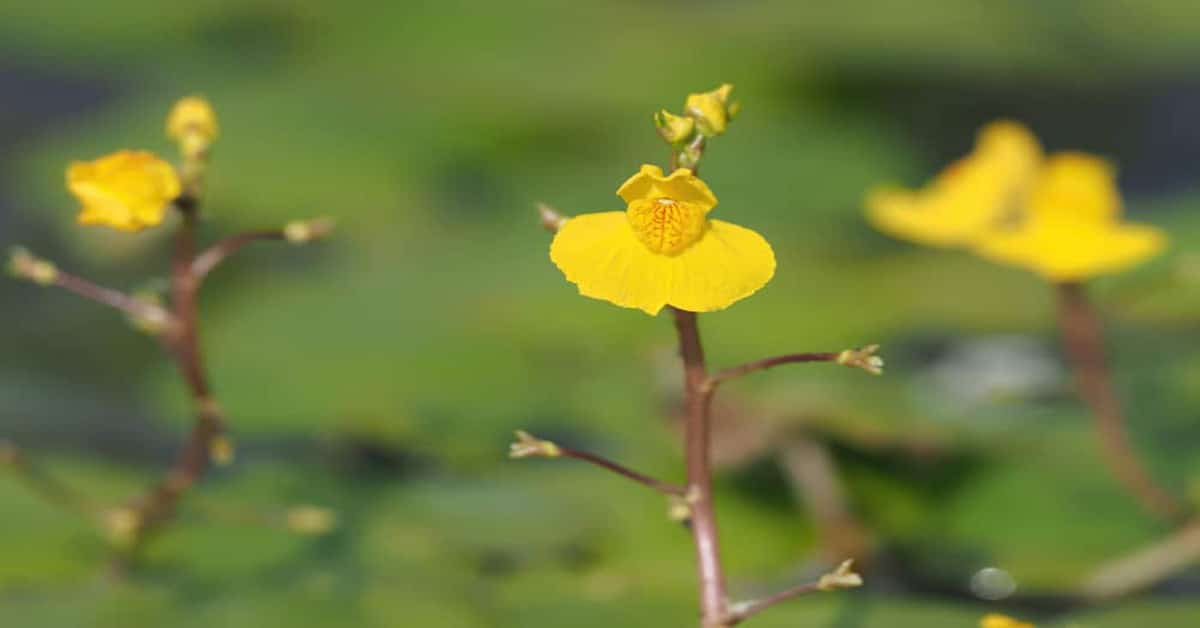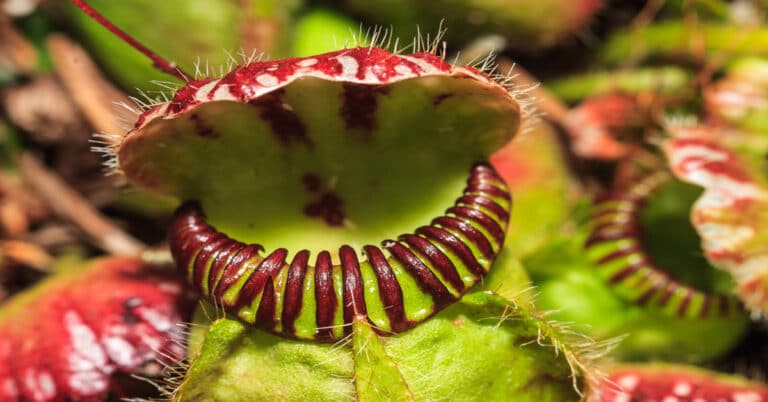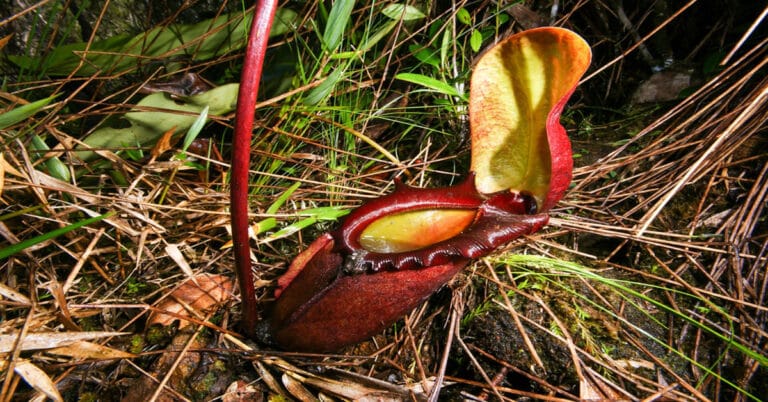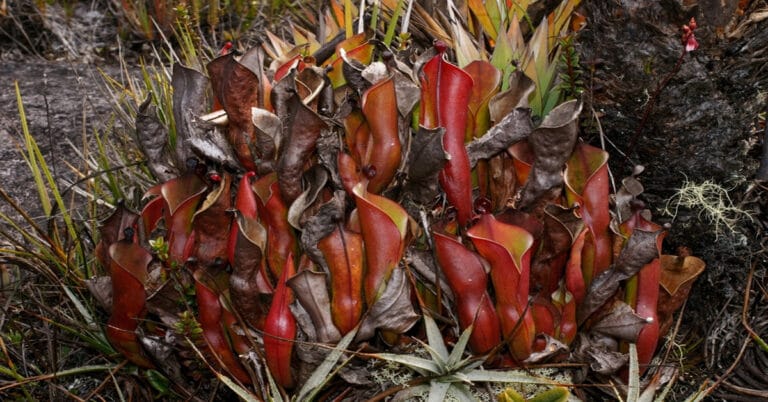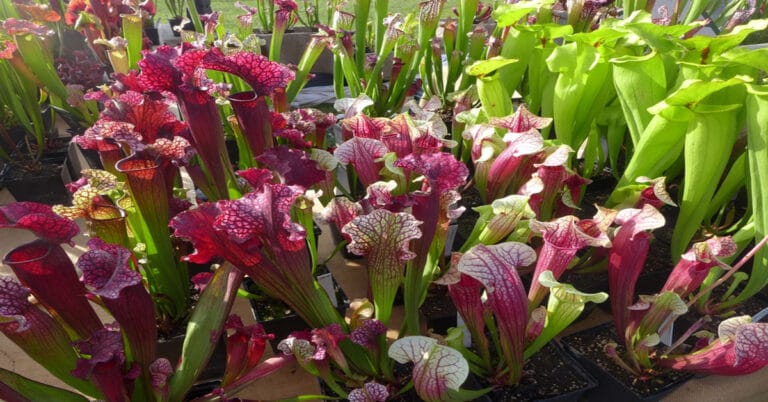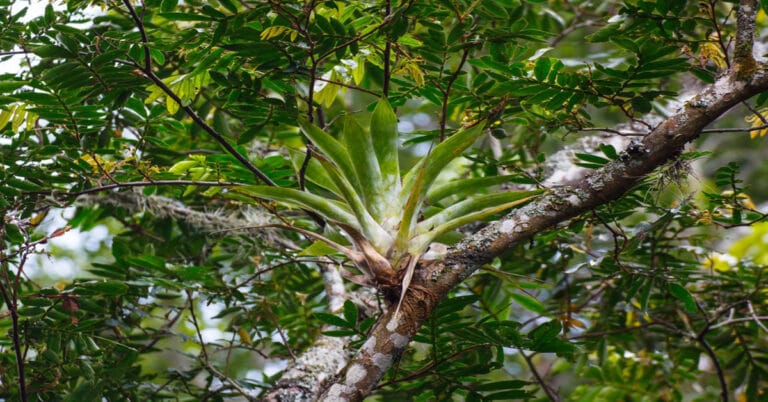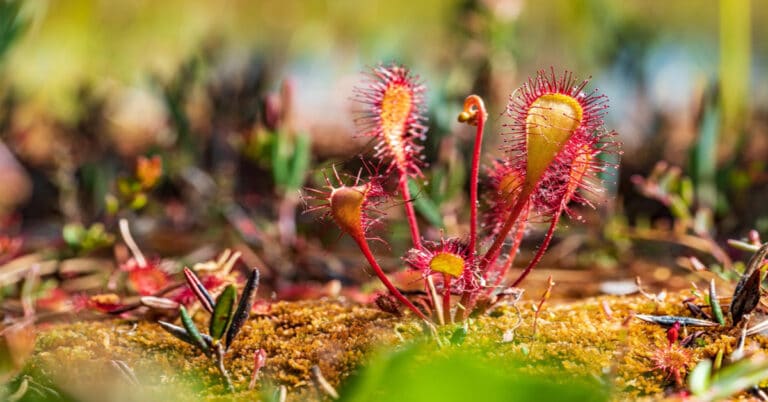Bladderworts
Most of you are surely acquainted with the Venus Flytrap, biological name Dionaea Muscipula and its amazing carnivorous, feeding habits, but how many of you are familiar with other hunting carnivores plants? Meet the Utricularia or the Bladderwort plant that has a trap working at almost 100 times the speed of a Venus Flytrap. The interesting facts about this plant are: They are freshwater plants they are competent hunters they float, and have no roots they attract and consume prey using miniature capsules with doors, lined with highly perceptive bristles
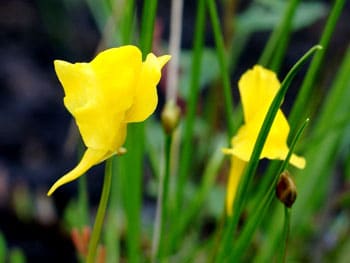
| Kingdom | Plantae (Plants) |
| (Unranked) | Angiosperms |
| (Unranked) | Eudicots |
| (Unranked) | Asterids |
| Order | Lamiales |
| Family | Lentibulariaceae |
| Genus | Utriculari |
Utricularia belongs to the carnivorous plant’s genus that has approximately 233 species (Categoication by different entities has arrived at different counts, but the most recent published record shows 215 species), and these are collectively called “Bladderworts.” They are inhabitants of clean water and moist soil. They grow on every continent on land and water other than Antarctica. Utricularia mainly plants for its flower. The flower of this plant is comparable to orchids and snapdragons and other carnivorous plants.
The name of the plant symbolizes bladder-like traps. Similarly, the generic name Utricularia derives from the Latin word Latinutriculusthat has many meanings, but it generally means leather bottle or wine flask. The aquatic species of this genus possess the largest bladder size.
Anatomy
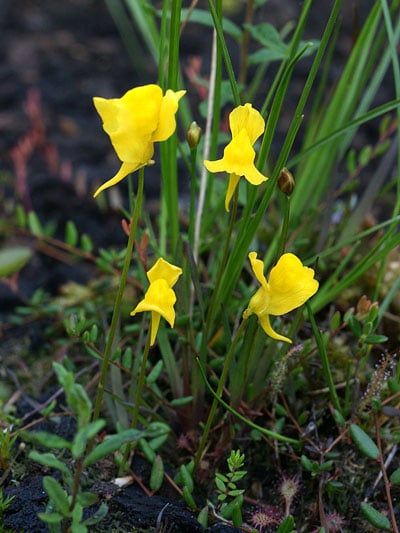
The Aquatic Carnivorous Bladderwortss lack roots, but float over the water. Its Flowers bloom on the stem raised above the water. The overall height of floating plant can be around 8 inches. The plant has a beautiful yellow colorful flower with a spur below the 3 lobes, that merge above the water.The petiole or the leaf branch is pulpy and hollow, allowing them to float in the water.. The leaves are coiled with 4- 10 tangential leaves.
Bladderworts is an extremely specialized and rare plant. Unlike other other angiosperms, the organs are not finely separated into stem, roots, leaves. The structure of bladder traps is identified as the most complex structure in the kingdom of the plants.
Most of the species of this Bladderworts have thin, long branching stems under the water, substrate However, water, substrate can be dripping moss or pond water. In aquatic species photosynthetic leaf and bladder traps are attached to stolons while in the terrestrial species, the shoot rises upward through the soil into the air.
The vital part of Bladderworts always lies under the surface. In terrestrial species, some photosynthetic leaves lay plane horizontal against the layer of the soil while in all other species, the stem will grow above. Therefore, most terrestrial species of the Bladderworts plant can be seen only if they are flowering, while the aquatic species can be visible beneath the water streams or pond.
Flowers
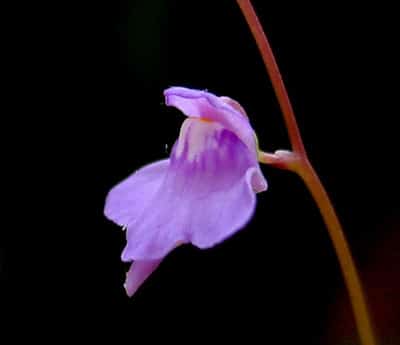
The carnivorous plants of Utricularia genus (Bladderworts Genus) belong to the Lentibulariaceae family. The Utricularia genus consists of 220 broadly distributed plant species, that are identified by tiny hollow sacs, they use to attack and sallow small creatures like aquatic worms, water fleas and insect larvae. Bladderwortss are usually found in ponds, lakes, waterlogged soil and streams all over the world and many insidious species are spread out to other habitats.
The plant of Bladderworts does not have roots. They have flat floating stem that bears simple and portioned leaves. The bladders are developed besides the stem. The color of a small bladder can vary from translucent to darker shades. The flower of Bladderworts plants is bilaterally symmetrical and bisexual. The flower has two stamens, superior ovary, 5 fused petals, 2 sepals. The ovary is segmented above the connection point of another part of flower and it is made up of two carpels. Every plant produces numerous seeds once they get mature.
This species of plant are usually assumed to have a large beautiful flower. This species are often compared with orchids.
Reproduction
Particular seasons may give rise to closed flowers that are closed, Cleistogamous or self-Pollinaring whereas the same species or plant blooms insect-pollinated open flowers in another time of the year, and do not follow any consistent pattern in the matter of producing closed and open flowers.
At times, a same plant can have both closed and open flower on it at a time. For example U. Geminiscapa and U. Dimorphantha are two aquatic species that bear both closed and open flowers. The open flowers float over the water while the closed flower lies under the water. Seed inside the flower are small in size and large in number. Most of the species are very small, about 0.2 – 1 mm in length.
Habitat
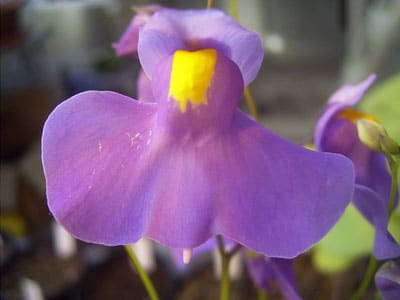
Utricularia species can live in any area. However, the area should have fresh water for half the year. These species you do not find in Antartica and few oceanic islands. The maximum species of Utricularia are seen in South America followed by the Austrilia. Like all Carnivorous plants, these plants also grow in wet soil that have poor mineral content. In this case, their carnivorous character proves beneficial to them.
Terrestrial members of Utricularia can be found often as representative of genera Drosera and Sarracenia in most of the areas that have moving water all the time and this removes the minerals in the soil.
Around 80 % of Utricularia species are terrestrial. They usually inhabit places with moist soil, or waterlogged areas where its small bladder can permanently stay immersed in water. They are often seen in swampy areas where the water is close to the surface. Although these species grow all over the world, this species prefers tropical regions.
About 20 % of of Utricularia species are Aquatic. They float freely over the water surface of the pond and other still water resources, swamp water and protrude the surface for flowering. Few of these are Lithophytic (a plant growing on stone or rocks) as they adapt to a life in the waterfalls or in other moving water. They are common to acidic water, but they also grow in alkaline water. They grow in alkaline water if the area does not have many plants around it. One member of aquatic specie is Utricularia Vulgaris that have stolons of one meter or longer, and spreads as branching rafts in ditches or ponds throughout Eurasia.
Some species grow even on spongy barks in rainforests and in wet moss. These species are called Epiphytes, and they are commonly found in South America. They even grow on the aquatic leaf of epithets (a plant growing non-parasitically on a tree, such as Tillandsia, a variety of Bromeliad that is endemic to rain forests.. Rosette-forming species of epithets like Utricularia Nelumbifolia that spread runners, searching for for opportunities to colonize other Bromeliads in their vicinity.
These plants adapt very well for their survival. They can also adapt to changing seasons,as its feeding habits and structure helps the plant to adapt. Some species are dormant and in a particular season, they get weak in their growth, while the warm and tropical temperature species do not require dormancy. Aquatic Bladderwortss in the cold zones of Siberia and UK produce buds on their stem during the winter and these buds are called Turions. As the growth slows down, the plants die due to the extremely freezing environment. But the Turions do not die, they get separated and float over the water surface and sometime sink in the pond or goes in the water to rest. During spring, these Turions come to the surface and start their growth. Many species belonging to Australia, grow only in wet season. When the season is dry, they shrink their length to 10 mm long only, while other species grow round the year irrespective of season.
The Bladder Traps
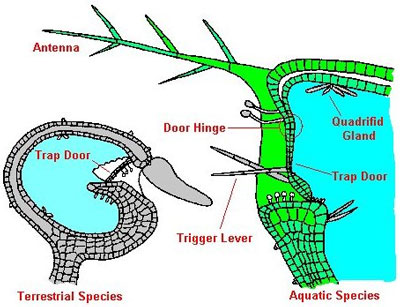
All species of Utricularia are carnivorous plants and catch small creatures with the help of their bladder traps.
The species that grow on land comprise traps that capture small prey that include Rotifers (belonging to microscope phylum) and protozoa floating in the soil that is water saturated. The size of trap can range from 0.2 mm – 1.2cm.
Aquatic species like Utricularia Vulgaris have a generally larger bladder that can feed and trap large prey like a fish, larvae, mosquito, water fleas, young tadpoles and nematodes. Even though they have a small size, their traps are highly complex. In the water species, the prey gets trapped when they rub against the hairs attached at the trapdoor. When the bladder is set at negative pressure as compared to the environment, and when the prey touches the hairs, the trapdoor triggers its trap and the prey, along with the surrounding water, is pulled towards the bladder. The bladder closes when it is filled with water. This entire process takes merely 300-500 μs (one millionth of a second) Uticularia’s exemplary bio-mechanical trap system gives it a tremendous incentive in trapping its prey. Bladderwort traps use an unbelievable suction force of nearly 600 G (600 times the gravitational force) against approximately 3.5 G, that Formula Iracing car drivers experience during a race.
There are minor differences in the bladder traps of the aquatic and the terrestrial species.
Aquatic
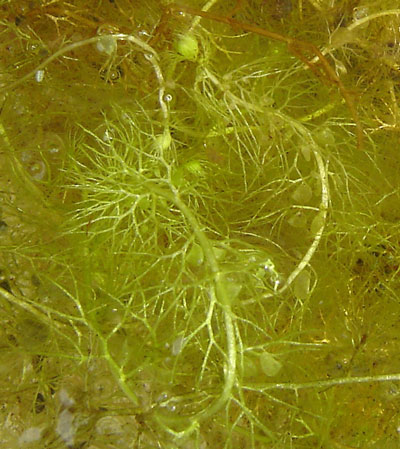
The Utricularia bladder of aquatic species has the most complex trapping mechanism that is ever found in any other species of kingdom of plants. The bladder generally has fat bean like shape and is connected to the stolons through the slender stalks.
The wall of the bladder is very transparent and thin. They are inflexible, but hold the shape in spite of the vacuum created in the process of the trap mechanism. The shape of the mouth is like an oval or circular flap. The upper part of the entrance is connected to the trap body by a flexible cell that forms a fine hinge. The mouth lies at the base created by the thick bladder wall. Velum, which is a soft membrane, elongates to the curve till the center of the platform and seals the door. The second group of cells (springly cells) passes through the lower edge of the door and offer flexibility to bottom edge of door to turn into a bent lip that can create a fine seal with velum.
The exterior cell of the entire trap secretes mucilage and beneath the entrance, mucilage is generated in large quantities and have sugar. The sugar mucilage helps in attracting the prey and assist in sealing.
The water species have the greater bladder up to size 1.2 cm and opening of the trap is surrounded by branching antennae, rather than beak like structure. This antenna helps in attracting the prey to the trap door and in protecting the mouth of the trap from greater bodies which may trigger the process unnecessarily. Epiphytic aquatic species have entrenched antennae that are bent from the front of the door and serve the similar purpose. Though, it is seen that they use capillary action to clutch a water pocket in front of the mouth, thereby assisting in the trapping mechanism.
Terrestrial
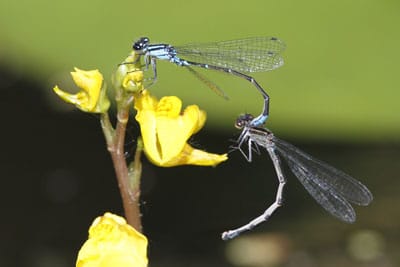
Species that grow on land usually have several small traps at a time, about 0.2 mm with a wide beak shaped structure, bending over the entrance, creating a pathway to the trapdoor and help with preventing the problems accruing from trapping and ingestion of inorganic particles.
Trap Mechanism
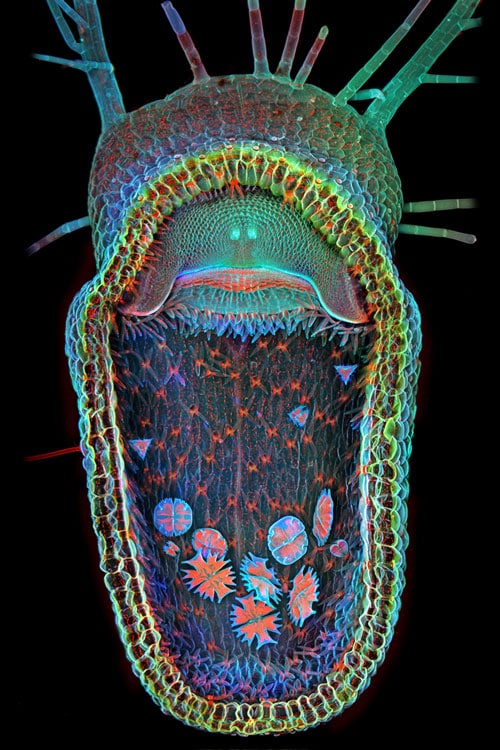
Photo by: Dr. Igor Siwanowicz.
1st Place, 2013 Olympus BioScapes Competition
Utricularia process of trapping is completely mechanical. Only the continuous pumping of water from the bladder wall is the active mechanism.
When the water is thrown out of a bladder, a temporary vacuum is created, which pulls the bladder wall inwards. The dissolved material in the bladder becomes thick and concentrated. Sides of bladder bend towards the inside, storing substantial energy like a spring. Now no more water will be pumped out and the trap is active, waiting for the repeat process.
A trap door will have its antennae stretched out from its bottom. They are like hairs or bristle- stiff. However, these triggers are different from the triggers that are found in Aldrovanda and Dionaea. These triggers are simple levers.
When something disturbs the seal, the wall of bladder immediately pushes back to create a fine round shape. Now the trap door opens the bladder and If the animal that disturbed the seal is small then it is inevitably drawn inside the bladder along with the water, and the door closes. This whole process gets complete in only very minute seconds.
Digestion Of Prey
Once the prey is swallowed, the digestive enzymes automatically digest it. The process takes few hours to complete. However, few protozoa are extremely resistant and can survive in the trap for many days. The wall of the trap continues to throw the water out of the trap. Now the bladder is again ready for its next attack. This occurs within 15-30 minutes.
Special Note
In cases where the environment does not have sufficient small insects, these carnivorous plants rely on to their secondary food source that gives them Phosphorous, carbon and organic nitrogen. Research claims that these plants may develop mutual relationships with another microorganism that are present around the bladder to get help in attracting the prey and in its digestion.
Growing Terrestrial Bladderworts At Home
The Bladderworts are mainly grown for their beautiful flowers. All the species of Baladderwort (Utricularia) give gorgeous flowers like the orchid flower. A bunch of Baladderwort flowers is both stunning and eye catching. Tropical Bladderworts can be grown very usually in some areas.
Container
You will need a 3 inch deep plastic pot
The temperature can range from tropical to alpine depending upon the species that you are growing.
Habitat
Most of Carnivorous plants that grown world wide on any biomes is Baladderwort. You can grow the terrestrial Bladderworts in sunny, peaty soil in very wet conditions. They often grow in combination with sphagnum moss.
Culture
Most terrestrial Bladderwortss grow in common carnivorous plant soil, which is a mixture of half part of sand and half part of peat. Though the peat- sand proportion is not important, many people prefer more peaty ratio, while the others prefer the live sphagnum moss.
Water
Keep the soil moist and use mineral-less water for Baladderworts. In this case the tray technique is superior. Keep the pot in a tray with at least 1.2 cm and 2.5 cm water inside it always during its growing season. The terrestrial species prefer a shady environment, while some opt for sunlight. Some of these species favor indirect low light. Terrestrial Bladderwortss grow healthy at room temperature, but some favor extreme warmth while some prefer extreme cold temperatures.
Dormancy
Some natives of temperate zone need dormancy. They usually die in late fall. Therefore, you would do well to keep the dormant plants dry while you retain the soil evenly wet. Terrestrial Bladderwortshs do not undergo dormancy and therefore they grow all around the year.
Feeding
The traps of Baladderworts are beneath the soil and small in size. They usually eat soil protozoa and nematodes. They attract the prey, then trap them all on their own. Hence, it is very unnecessary and difficult to nourish them.
Other Considerations
Bladderworts are usually grown for their flowers. They spread fast and gives a beautiful display. You can grow several species together.
- Most of the terrestrial Bladderwortss provide flower and seeds readily, while some may turn out as weeds. The seeds of terrestrial Bladderwortshs are small in size and can be gathered by trembling the stalk of flowers over a little tray
- You can grow many terrestrial Bladderworts by dividing the roots(root-division) . Dig a small section of the plant and transplant it in clean moist soil.
- Use fresh CP soil mix and repot the plants every year to prevent problems associated with a breakdown of the existing peat mix, causing drainage problems. Preferably in spring, before the commencement of active growth, divide the plant.
- Terrestrial Bladderworts make for a good terrarium plant. Place them in ventilated sealed transparent pots beneath fluorescent lights for 16 hours in a day. Place the lights about 6 inches away from the plant.

Having discovered a fondness for insects while pursuing her degree in Biology, Randi Jones was quite bugged to know that people usually dismissed these little creatures as “creepy-crawlies”.

